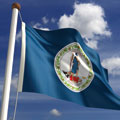Inspectors from the Old Dominion State are very active in the code change process.

If you did a quick check of the public comments to this year’s code changes to the International Plumbing Code, you would swear Virginia was dominating the code. However, that is somewhat deceiving in that all the comments from the Code Action Committee list the name of the chairman, who happens to be from Virginia.
There is no denying that the Virginia Plumbing and Mechanical Inspectors Association is very active in the code change process. Other than the CAC, it has again submitted the most public comments to the plumbing code. Virginia always doubles up and lists the Virginia Building Officials Association.
Some think Virginia is trying to control the contents of the plumbing code. In reality, the inspectors from Virginia are just very involved, more involved than inspectors from other states. Perhaps the next closest state with representation is Colorado. There are also comments from Utah and Michigan inspectors.
What is surprising is the number of public comments. There were 72 comments submitted to the plumbing code. Some of the comments are very good, others are unreasonable.
The CAC is attempting to add the changes the Code Change Committee originally rejected. The first public comment will be a complete overhaul of the graywater piping section. Some objected to a few minor points, hence the CAC responded by changing those requirements. They deal with the definitions of storage tanks and distribution piping. Both definitions are proposed to be deleted from the original text.
Some, including one of the public commenters, believe nonpotable water systems belong only in the Green Code. I couldn’t disagree more. The Green Code is a goal-oriented code. The Plumbing Code is a set of mandatory requirements. Thus, if you want to install something in accordance with the Green Code, the basic requirements better be in the Plumbing Code.
Delving into change proposals
A public comment that could have a serious impact on design would require protective shields if piping is run parallel to framing members and is located within 1 1/2 in. of the framing member. The thought process is if someone misses the framing member, he could hit the pipe and penetrate it. The result is you could have a protective shield running the entire length of a wall or ceiling.
While there was good intention, the problem with this change is the installation of the protective shield. One normally nails or screws the protective shield to the framing member. If you do that for the length of the cavity, you cannot secure the wall or ceiling membrane to the framing member. The entire length would have a protective shield.
If you attach the shield to the face of the framing member, you cannot attach the pipe with hangers to that framing member. Someone missed a step in the preparation of this change. If it is successful, it will add significant cost to a plumbing installation.
Other design issues up for consideration include adding a requirement for a fixture to connect upstream of a nonwater-supplied urinal. This was foolishly added to the International Green Construction Code. The CAC is attempting to make the two codes consistent. However, the change should be to the Green Code, not the Plumbing Code.
There is a proposal to allow public lavatories to have a single water pipe supply. This is already permitted, however this change will limit the temperature of the water to between 70° and 85° F. Currently, the water would have to be between 85° and 110°. The change also would modify the definition of tempered water as being between 70° and 110°.
I am the proponent of a series of changes to revise the storm drainage sizing protocol. The change would require greater engineering when designing a storm drainage system. The amount of ponding at the roof drain would have to be determined based on the rainfall rate and the flow rate through the roof drain.
This change was developed based on the research conducted by the ASPE Research Foundation. The paper, to be published in October, identifies that plumbing engineers have been improperly designing roof drainage systems for the last 80 years. The paper will be presented at the ASPE convention on Oct. 31 in Charlotte, N.C. More on the ASPE RF paper next month.
Go with the flow
Maximum flow rates and water consumption are a part of one public comment. The comment revises the original submittal raising some of the water use requirements. Water closet use would remain at 1.6 gpf under the revised change. The original proposal was to lower the rate to 1.3 gpf. I happen to like the lower rate, but politics seems to be winning out, unfortunately.
Showerheads would also stay the same at 2.5 gpm. Originally, the change would lower the rate to 2.0 gpm.
Other fixtures would have lower flow rates or consumption values. A urinal would drop to 0.5 gpf, while private lavatories would drop to 1.5 gpm.
There are a few changes to interceptors and separators. One change would prohibit grease interceptors from discharging through a hydromechanical grease interceptor. This is common practice, but some jurisdictions actually require it. Another change will remove the requirement that elevator pit discharge be through an oil separator. The code has never been clear on this requirement and the change would result in an interceptor not being required. This is a change that every engineer should embrace.
The discussion and voting on these public comments will take place the week of Oct. 22 in Portland, Ore. This is the final vote to determine the content of the 2015 International Plumbing Code. That’s right, the 2015 code will be completed in 2012.
You can download the public comments at www.iccsafe.org. If you cannot attend and would like to watch the code change hearings, they can be viewed on ICC’s website.


